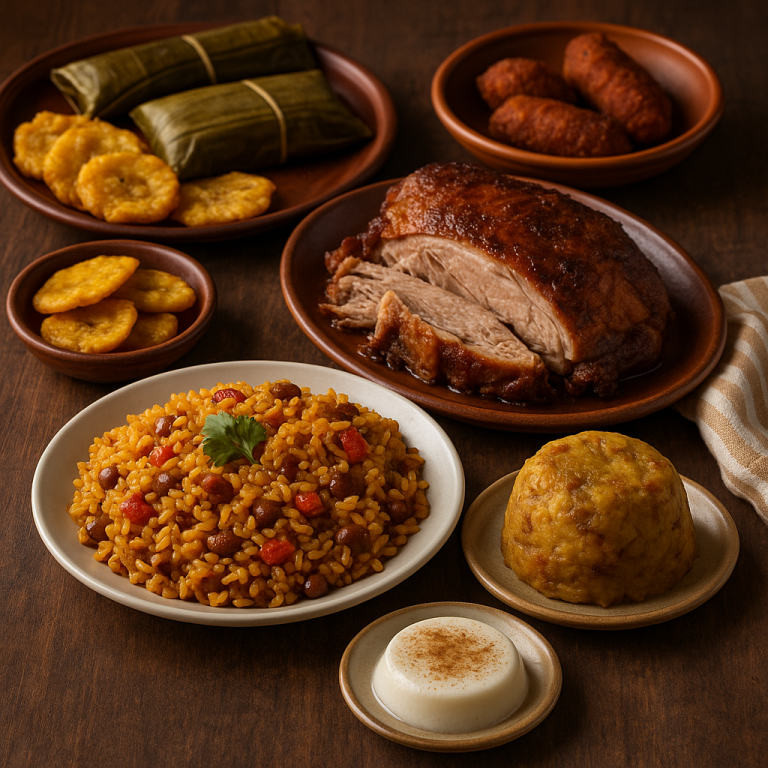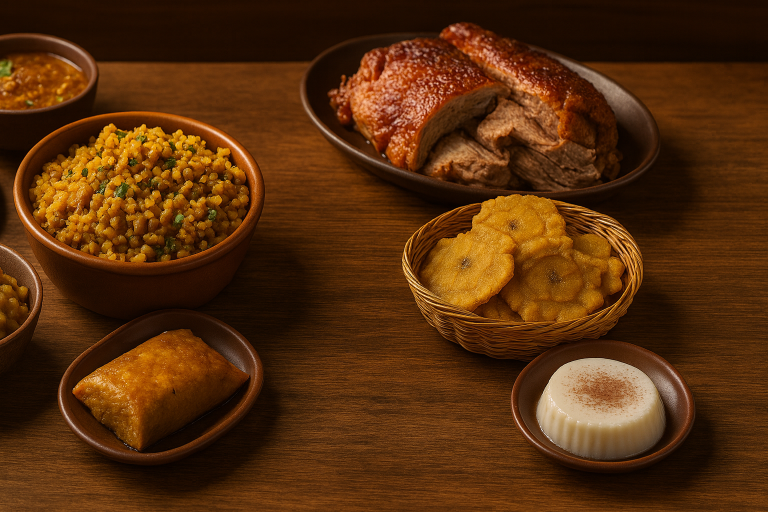Puerto Rican Cuisine:
A Flavorful Blend of History, Hospitality, and Heritage

Courtesy of My Neighbors:
Puerto Rican cuisine, known locally as “comida criolla,” is more than just food. It is a vibrant tapestry of history, culture, and love served on a plate. From the island’s Indigenous Taíno roots to the influence of Spanish colonization, African heritage, and American presence, Puerto Rican dishes tell the story of resilience, adaptation, and celebration. But beyond the recipes lies a cultural tradition that may surprise outsiders: an enduring food obsession and an unspoken rule that no guest should ever leave a Puerto Rican home hungry.
Why Puerto Ricans Are Known for Feeding Everyone
The Puerto Rican love for abundant food is deeply tied to cultural values of hospitality, family, and pride. For centuries, the island faced economic struggles and periods of scarcity. Being able to offer food, especially in generous amounts, became a symbol of dignity and warmth. Serving a guest a plate piled high is not just about feeding them; it’s about showing respect and affection.
In Puerto Rican households, it’s common to hear, “¿Comiste?” (“Have you eaten?”) before any conversation begins. Declining food might even be taken as an insult, as it’s considered a personal gesture of care. This tradition stems from:
Taíno and African communal feasts where food was shared as a sign of unity
Spanish Catholic influences which emphasized family gatherings around large meals
A belief that food is love, and to feed someone is to show them you care
The Roots of Puerto Rican Cuisine
Puerto Rican food is a fusion of Taíno, Spanish, African, and later American influences, each contributing unique ingredients and cooking techniques
Taíno Heritage
The island’s original inhabitants introduced ingredients like yuca (cassava), batata (sweet potato), and tropical fruits. They pioneered barbacoa, the precursor to modern barbecue, and made casabe, a flatbread still enjoyed today
Spanish Influence
The Spanish colonizers brought rice, pork, olive oil, garlic, onions, and sofrito, a mix of aromatics used as a flavor base. They also introduced gandules (pigeon peas) and Mediterranean spices, which are now staples of Puerto Rican cooking
African Influence
West African slaves brought with them plantains and frying techniques that transformed the island’s cuisine. Dishes like mofongo, mashed plantains with garlic and pork cracklings, and fritters such as alcapurrias, made with green bananas and yautía, have clear African roots
American Influence
After 1898, U.S. influence introduced canned goods, processed cheeses, and quick-cooking ingredients. Comfort foods like arroz con salchichas, rice with Vienna sausages, emerged during this era, blending convenience with Puerto Rican flavors
Traditional Puerto Rican Dishes You Must Try
Puerto Rican cuisine is rich in flavor, often seasoned with adobo, sofrito, sazón, and achiote oil. Here are some iconic dishes:
Arroz con Gandules – The national dish, rice cooked with pigeon peas, pork, and sofrito
Pernil – Slow-roasted marinated pork shoulder, often served during holidays
Mofongo – Fried and mashed green plantains, mixed with garlic and pork cracklings
Pasteles – Similar to tamales, these are dough parcels made from green bananas and yautía, filled with seasoned meat
Tostones – Twice-fried green plantain slices, crunchy and salty
Alcapurrias – Deep-fried fritters made from green bananas or yuca, stuffed with beef or crab
Asopao de Pollo – A thick chicken and rice stew, reminiscent of gumbo
Tembleque – A creamy coconut pudding, often topped with cinnamon
Eating Behavior: More Than Just Food
For Puerto Ricans, meals are celebrations of life. There is a belief that food brings people together, whether it’s a weekday lunch or a festive Christmas feast. This cultural approach to food is why:
Guests are encouraged to eat seconds or thirds
“Para llevar” (to-go plates) are often packed for visitors
Celebrations, no matter how small, always involve a spread of home-cooked dishes
The generosity with food reflects a broader cultural value: hospitality is sacred. When you step into a Puerto Rican home, you’re not just a guest, you’re treated like family
Wait… Didn’t You Just Eat?
It’s not at all uncommon in Puerto Rican culture to visit multiple households in a single day and somehow end up eating a full plate at every stop even if your stomach has already waved the white flag. Politely declining isn’t usually an option. Instead, you’ll be greeted with a firm “¿Pero cómo que no vas a comer?” followed by a plate the size of your torso
Why? Because in Puerto Rico, offering food is a badge of honor, and accepting it shows respect and gratitude. Each family member believes their rice, their pernil, and their pasteles are the best, so naturally, you must try them all
And here’s the plot twist: if you’re family, don’t be surprised when after being lovingly overfed all day the very same relatives who force-fed you with pride turn around and say, “Mira nene… you’re getting kinda gordito, huh?” That’s not shade, that’s love with a little roasted garlic on top. Welcome to Puerto Rico, where the plates are full and the honesty is free
Conclusion
Puerto Rican cuisine is a heartfelt reflection of the island’s history and people. It blends the ancient flavors of the Taíno with the richness of Spain, the soul of Africa, and modern influences from America. But beyond the recipes, Puerto Rican food is a symbol of love, pride, and community. Whether you’re savoring arroz con gandules or digging into a plate of mofongo, know that every bite carries centuries of stories and probably an offer for seconds
Sources and References
Cruz Miguel Ortiz Cuadra, Eating Puerto Rico: A History of Food, Culture, and Identity (University of North Carolina Press, 2013)
National Museum of American History, Smithsonian Institution – Puerto Rican Foodways: https://americanhistory.si.edu
Puerto Rico Tourism Company – Gastronomy & Cultural Traditions: https://www.discoverpuertorico.com
The Latin Kitchen – Puerto Rican Food Culture: https://thelatinkitchen.com
Boricua Roots: Oral histories and family traditions of Puerto Rican cuisine








Pro-Advice is your trusted partner for excellence and transformation, offering tailored professional services to empower businesses. Our team of experts provides personalized solutions designed to meet your unique goals, with services ranging from business consulting, marketing and web development to mobile notary services.
Operating across Georgia, Texas, South Carolina, and Florida, we bring localized expertise to help businesses thrive. Choose Pro-Advice for expert guidance, comprehensive support, and peace of mind as you achieve growth and long-term success.






Get involved!
Comments